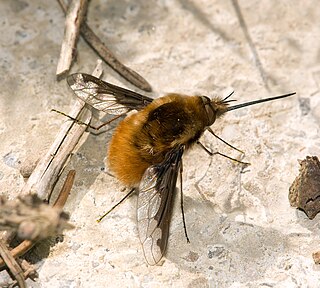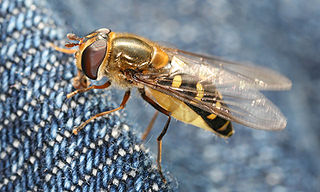
Hoverflies, also called flower flies or syrphids, make up the insect family Syrphidae. As their common name suggests, they are often seen hovering or nectaring at flowers; the adults of many species feed mainly on nectar and pollen, while the larvae (maggots) eat a wide range of foods. In some species, the larvae are saprotrophs, specifically detritivores, eating decaying plant and animal matter in the soil or in ponds and streams. In other species, the larvae are insectivores, preying on aphids, thrips, and other plant-sucking insects.

A crane fly is any member of the dipteran superfamily Tipuloidea, which contains the living families Cylindrotomidae, Limoniidae, Pediciidae and Tipulidae, as well as several extinct families. "Winter crane flies", members of the family Trichoceridae, are sufficiently different from the typical crane flies of Tipuloidea to be excluded from the superfamily Tipuloidea, and are placed as their sister group within Tipulomorpha.

The Bombyliidae are a family of flies, commonly known as bee flies. Some are colloquially known as bomber flies. Adults generally feed on nectar and pollen, some being important pollinators. Larvae are mostly parasitoids of other insects.

Horse-flies and deer flies are true flies in the family Tabanidae in the insect order Diptera. The adults are often large and agile in flight. Only female horseflies bite land vertebrates, including humans, to obtain blood. They prefer to fly in sunlight, avoiding dark and shady areas, and are inactive at night. They are found all over the world except for some islands and the polar regions. Both horse-flies and botflies (Oestridae) are sometimes referred to as gadflies.

The Tephritidae are one of two fly families referred to as fruit flies, the other family being the Drosophilidae. The family Tephritidae does not include the biological model organisms of the genus Drosophila, which is often called the "common fruit fly". Nearly 5,000 described species of tephritid fruit fly are categorized in almost 500 genera of the Tephritidae. Description, recategorization, and genetic analyses are constantly changing the taxonomy of this family. To distinguish them from the Drosophilidae, the Tephritidae are sometimes called peacock flies, in reference to their elaborate and colorful markings. The name comes from the Greek τεφρος, tephros, meaning "ash grey". They are found in all the biogeographic realms.

Bibionidae is a family of flies (Diptera) containing approximately 650–700 species worldwide. Adults are nectar feeders and emerge in numbers in spring. Because of the likelihood of adult flies being found in copula, they have earned colloquial names such as "love bugs" or "honeymoon flies".

Eupeodes americanus, the American hoverfly, is found throughout North America and inhabits meadows, and fields with flowers and foliage. Adults feed on nectar, whereas their larvae feed on aphids. The adult fly is black to metallic green, and has three yellow bands on its abdomen. Its face is a light yellow with large black compound eyes on either side, and its wings are clear; it is 9–12 mm in body length. The larvae are mature at around 11 mm, and they are yellow-white to salmon brown, with markings of black and white or yellow-white. The lighter markings consist of a transverse rectangular bars on segments 6 to 11, and a narrow line along each side of the larvae. Early instars have visible black setae. The larvae are active feeders. They are being considered as suitable biological control agents for aphids and scale insects. This species is considered highly migratory, moving from Canada to the southeastern United States during autumn

Bombylius major is a parasitic bee mimic fly. B. major is the most common type of fly within the Bombylius genus. The fly derives its name from its close resemblance to bumblebees and are often mistaken for them.

Syritta pipiens, sometimes called the thick-legged hoverfly, is one of the most common species in the insect family Syrphidae. This fly originates from Europe and is currently distributed across Eurasia and North America. They are fast and nimble fliers, and their larvae are found in wet, rotting organic matter such as garden compost, manure, and silage. The species is also commonly found in human-created environments such as most farmland, gardens, and urban parks, wherever there are flowers. This species is an important part of its native ecosystem as adult Syritta pipiens flies are critical pollinators for a variety of flowering plants and the species supports parasitism by various parasitic wasp species. Thus, they play an important role in environmental functionality, and can serve as bio-indicators, in which their abundance can reflect the health of the environment. Syritta pipiens looks like many predatory hoverfly species, yet is not predatory.

Eupeodes, the aphideater flies, are a genus of moderate hoverflies in the family Syrphidae. They are distributed worldwide. They are black with yellow markings and can be easily confused with other genera in the Syrphini tribe. Larvae feed on a wide variety of aphids. The adults feed on nectar and pollen as sources of energy and protein, respectively, and often hover over the plants they visit.

Eupeodes corollae is a very common European species of hoverfly. Adults are 6–11 millimetres (0.24–0.43 in) in body length. Males and females have different marking on the abdomen; males have square commas on tergites 3 and 4, whereas females have narrow commas. Larvae feed on aphids. This species has been used experimentally in glasshouses as a method of aphid control, and to control scale insects and aphids in fruit plantations. They were found to be partial to the fruit, eating more fruit than aphids.
Eupeodes snowi is a species of syrphid fly in the family Syrphidae.

Sericomyia lata , the White-spotted Pond Fly , is a common species of syrphid fly observed across North America, concentrated in the east. Syrphid flies are also known as Hover Flies or Flower Flies because the adults are frequently found hovering around flowers from which they feed on nectar and pollen. Adults are 11.6–15.2 mm (0.46–0.60 in) long and black with large white abdominal spots. The larvae of this genus are known as rat tailed maggots for the long posterior breathing tube.

Eupeodes fumipennis, the western aphideater, is a species of hover fly in the family Syrphidae. As the common name implies, larvae prey on plant-sucking insects, primarily aphids.

Eupeodes flukei is a species of syrphid fly in the family Syrphidae. It is found in North America, generally from Colorado to the northwest.
Syrphus rectus, the yellow-legged flower fly, is a species of fly in the family Syrphidae, the hover flies. Syrphus rectus is a common fly in the eastern United States and southeastern Canada and has occasionally been seen in Europe. Like many hoverflies, it has strongly contrasting black and yellow bands on the abdomen.

Lapposyrphus lapponicus, the common loopwing aphideater or Lapland syrphid fly, is a common species of syrphid fly observed across the Northern Hemisphere. The adults are commonly found on flowers from which they get both energy-giving nectar and protein rich pollen. Larvae feed on aphids.
Total of 245 species either found or highly expected to be found in New York.

Eupeodes perplexus, the bare-winged aphideater, is a species of hoverfly native to North America. Adults feed on nectar; larvae feed on aphids and scale insects.

















